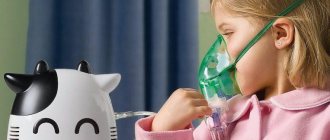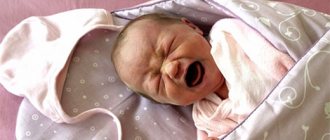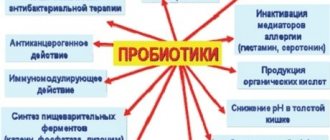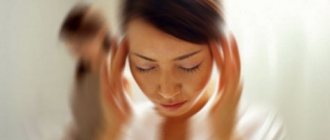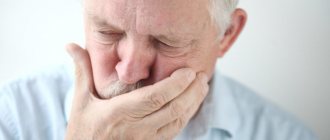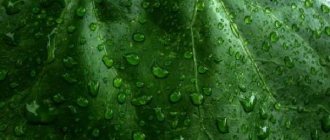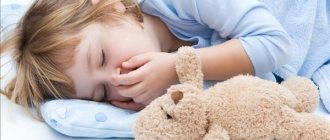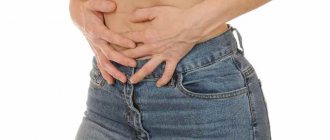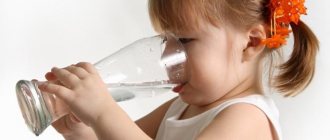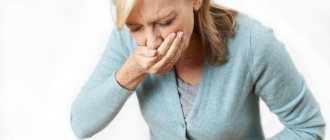Signs of diarrhea in a child
Diarrhea, or diarrhea, is loose stool that occurs more than twice a day. In addition, childhood diarrhea is characterized by the presence of certain signs:
- The increase in single intestinal discharge is greater than normal.
- Increased frequency of bowel movements more than 3-4 times a day.
- The presence of mucus, foam and just water in the stool. Infants may pass small lumps of stool and mucus.
- The presence of blood in the stool during amoebiasis.
- Change in the color of stool - the color of the child’s diarrhea is yellow or green.
- Sour and pungent odor of feces, indicating intoxication.
- Rumbling in the stomach and flatulence.
- “Rectal colic” - convulsive contractions of the rectum and frequent urge to defecate.
Infectious or viral diseases often have “concomitant” symptoms – high fever, vomiting.
How to distinguish loose stools from diarrhea?
- A lot of fluid in the stool;
- Small amounts of feces are expelled whenever the baby is stressed;
- Greenish stool with mucus;
- Foul (sour) odor;
- Flatulence in a child;
- Exit of feces in a fountain.
Yellow diarrhea in a child is caused by flaws in the mother's diet.
Eating sour, carbonated, and fermented foods causes fermentation in the baby’s intestines.
A more serious cause is inflammatory and infectious diseases, for which it is a symptomatic sign.
Types of baby diarrhea
Physiological – in the first days during the “tuning” of the digestive tract.
Associated with complementary feeding and the appearance of new foods in the diet.
Infectious: bacterial (for salmonellosis, dysentery) and viral (for infection with rotavirus, adenovirus and viral hepatitis). In the latter case, there is a rather long incubation period (up to 3 weeks). Infectious diarrhea occurs with fever, vomiting, and abdominal pain.
Toxic. Appears when the body is poisoned with salts of heavy metals or with kidney or liver failure.
Nutritional. Occurs when there is a malnutrition or monotony.
Allergic – with intolerance to certain foods.
Medication - after taking certain medications, diarrhea occurs especially often after antibiotics: they lead to an imbalance of microflora in the intestines and dysbiosis.
Neurogenic – as a result of stress or fear.
Infestation by worms, protozoa or fungi.
Disruption of microflora growth in the intestines after acute diarrhea.
Change of climate and living conditions - food and water. It may go away on its own after adaptation.
Hereditary pathology - cystic fibrosis, lactase deficiency and deficiency of other enzymes, celiac disease, congenital intestinal abnormalities.
When you need a doctor's help
If children have loose stools, then it is advisable to consult a doctor. It is especially important to do this if the discharge is green.
As soon as parents have discovered the corresponding signs, and their child feels well, then they should consult a doctor. It will be necessary to undergo tests to immediately determine the cause of the disease
. If dysbiosis is detected, the doctor will have to prescribe medications with antibacterial properties. Also needed are drugs that will reduce the intensity of the main symptom, will delay the loss of moisture in the body, as well as immunostimulating drugs.
In case of acute abdominal pain, severe vomiting, a sharp increase in body temperature and general weakness, parents will have to call an ambulance at home, since it would be a mistake to take a sick child in this condition to the hospital. If the cause is an intestinal infection, then treatment should be carried out under the strict supervision of doctors, especially if the patient is not yet 2 years old.
To prevent dehydration, doctors may give IVs.
The danger of dehydration due to diarrhea in a child
Regardless of the color of profuse diarrhea, dehydration as a result occurs much faster in infants and young children than in adults, and is manifested by a number of signs.
- Retraction of the parietal fontanel.
- Crying without tears.
- Dry skin and mucous membranes.
- Rare urination (once every 5-6 hours), darkening, decreased amount and strong odor of urine.
- Gray skin tone.
- "Sunken eyes.
- Lethargy, drowsiness.
The occurrence of dehydration is fraught with serious complications.
- Imbalance of electrolytes in the body.
- The appearance of uremic syndrome.
- Cerebral edema, neurotoxicosis, convulsions, infectious-toxic shock.
- Development of encephalitis, otitis, duodenitis, asthma, dermatitis, pyoderma.
- Hypovitaminosis.
- Death.
Changes in diarrhea color and stool structure
When diarrhea in children, it is important to pay attention to the color of the stool and the presence of impurities in it - blood, mucus and flakes. The color of stool may change depending on the foods that the baby ate - after all, stool is formed from food debris.
Therefore, when changing the usual color of stool to an unusual one, the first step is to remember what the child ate 12 hours before the strange stool appeared.
1). The usual color of stool is brown or shades of brown. Depending on the amount of meat in the diet, the color of the child's diarrhea will be either light brown (a little meat) or dark brown (a lot).
2). Iron and activated carbon color stool a dark, almost black color. The same feces occur when bleeding from the esophagus and stomach occurs when hemoglobin in the blood is bound by hydrochloric acid of the gastric juice.
3). When there is a large amount of vegetables or berries in the diet, they color the stool in the corresponding color: blueberries - dark, broccoli - green.
4). Frequent, liquid green stool is a sign of infection with bacteria (salmonella, staphylococcus) or viruses. This diarrhea is accompanied by abdominal pain, fever, nausea and vomiting.
5). In children of the first year of life, green diarrhea may be a sign of dysbiosis. More common in formula-fed children. It can appear due to an allergy to milk, with an incorrect diet and after treatment with antibiotics.
6). Dark green color of diarrhea appears when complementary feeding rules are violated. Most enzymes begin to be produced after 3 years of age, so often the intestines are not able to digest new foods. Hence the diarrhea. As a rule, it occurs without a rise in temperature.
7). The usual color of diarrhea in an infant is yellow. Light yellow stool will be observed with a large amount of dairy products in the diet. Yellow, watery stools are not normal and are observed in a number of conditions:
- pancreatitis;
- biliary dyskinesia;
- helminthic infestation;
- Mom’s poor diet – the diet contains a lot of fatty and spicy foods.
8). White feces indicate the presence of acute (viral hepatitis) or chronic (chronic hepatitis, liver cirrhosis, liver failure) liver pathology. And also about obstruction of the bile ducts and liver intoxication with certain medications (antibiotics, paracetamol).
9). An admixture of mucus in the stool indicates a violation of the digestive process and intestinal diseases: when inflamed, the glands that secrete mucus work more actively.
10). The presence of scarlet blood in a child’s stool indicates damage to blood vessels in the anus or lower part of the large intestine: possibly the appearance of microcracks, which can lead to infection and the development of inflammation. The presence of dark blood clots may be a sign of intestinal bleeding.
eleven). The presence of flakes in the stool is a sign of candidiasis (infection with fungi of the genus Candida). The disease is typical for young children. It proceeds without a rise in temperature.
12). If there are flakes in liquid stool with a rise in temperature, vomiting and abdominal pain, you can think about the presence of rotavirus infection.
Treatment
If a child over 1 year of age has white diarrhea and there is no positive dynamics within 24 hours, and even more so if such a picture is observed in an infant, then you should definitely seek medical help. Whatever the reason behind the appearance of diarrhea in children, during the treatment process it would be good to adhere to the following rules:
- Proper balanced nutrition. In some cases, of course, hunger is appropriate, but in general, with severe diarrhea that lasts more than one day, the child’s nutrition should be such that he retains vital energy. The diet should be gentle and may include lean meat, natural yogurt, cereals, baked or stewed vegetables and fruits. It is important to exclude foods that themselves have a laxative effect or are considered harsh.
- Proper drinking regime. Under no circumstances should you replenish fluid deficiency during frequent bowel movements with sweet drinks (juices, lemonades, sweet tea). Carbohydrates, which such drinks are rich in, will only aggravate the child’s condition, since they promote the release of fluid from the intestines. To avoid dehydration, you need to drink plenty of clean water without gases and saline solutions.
- Maintain high level of hygiene. If the baby is still wearing diapers, then they should be changed after each bowel movement, including those cases when the discharge was insignificant. If the child has bowel movements very often, then during this period it is worth giving up toilet paper and resorting to washing with baby or tar soap. If the perianal area is already irritated, then you can use sea buckthorn oil or creams with panthenol to heal and protect the skin.
If, during the examination of a baby with white diarrhea, a serious pathology is diagnosed (hepatitis, bile stagnation, dysbacteriosis or rotavirus infection), then comprehensive treatment will be prescribed aimed at eliminating the underlying disease.
The cessation of diarrhea in the case of serious pathology does not indicate complete recovery . In addition, the body that has suffered from the disease requires special care. To prevent unpleasant symptoms from returning with renewed vigor, it is necessary to adhere to a diet for some time - fatty, spicy, fried foods are unacceptable. Feeding should be frequent, but fractional.
If a child has white or light-colored diarrhea, then you should not immediately panic and sound the alarm. However, negligence in this case is also inappropriate. Self-medication, especially when it comes to very young children, can lead to dire consequences. And if parents have good contact with the local pediatrician, then a serious pathology is unlikely to be missed.
How to treat diarrhea of a non-standard color in a child
Mandatory consultation with a pediatrician.
Nutrition correction.
Exclude fatty foods, rich pastries, fresh fruits and vegetables, fruit juices, carbonated drinks, cabbage in any form, and wholemeal bread. Do not give fermented milk products!
Give more porridges with water, boiled vegetables, omelettes, weak broths with crackers, pureed soups, bananas.
For diarrhea in infants, switch to lactose-free formulas. The best remedy is mother's milk, so don't stop feeding.
Medicines
If a pathogen is identified, take antibacterial drugs: Tetracycline, Levomycetin, Furazolidone.
Taking probiotics: Bifidumbacterin, containing live bacteria. It has no contraindications and is completely safe.
“Acipol-baby” is a complex probiotic that increases the active functions of the body and helps digest and assimilate food. Normalizes intestinal flora. Does not contain lactose! These drugs are indicated both for infectious diarrhea and for dysbiosis in chronic pathology.
Enterosorbents: activated carbon. Not absorbed, absorbs toxins and removes them with feces. Has no contraindications. It is taken at the rate of 250 mg of coal per 15 kg of child weight. Before use, crush to a powder consistency and stir in water - this way the coal particles will not damage the baby’s mucous membranes.
Linux for children.
Rehydration: drink plenty of fluids (clean water, fruit drinks, salted water) and Regidron.
After 2 years, you can give drugs that reduce peristalsis and increase the tone of the anal sphincter - Loperamide and Lopedium. Imodium, a drug from the same group, is given after 6 years. They are “first aid” means.
Antipyretic and pain relievers for fever - Panadol, Nurofen.
Antihistamines for food allergies.
Antifungal when sowing fungi from feces.
For decreased acidity of gastric juice, pancreatitis and gallbladder diseases - enzyme preparations: Pancreatin, Festal, Mezim.
Yellow diarrhea after taking antibiotics
Diarrhea after antibiotics
Antibiotic treatment has a negative impact on the functioning of the digestive system. Changes in the child's intestinal microflora lead to the development of diarrhea.
Now manufacturers have begun to produce drugs that do not suppress the activity of beneficial microorganisms. Therefore, they can be used for a long time. Most antibiotics have side effects that can cause digestive upset.
Before taking medications, you should always consult your pediatrician. For children who have been treated with antibiotics, the doctor prescribes probiotics.
